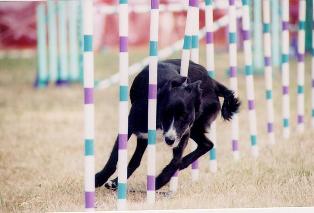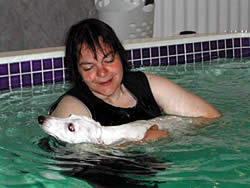Weekend Warriors and Winter Couch Potatoes:
How can we help to turn them into true Canine Athletes?
By Debbie LaMonica
ACWT Therapist, Washington
It looks like it is springtime here in Washington. I say this not because it FEELS that way when I walk out my front door, but because the calendar says so. Pretty soon, what the calendar says, and what my senses feel, will match one another. This time of year, the thoughts of many a dog fancier turn to athletic endeavors with our dogs. Field trials, Lure coursing, Racing, Agility, Flyball, Jogging for Fun and Fitness, Carting, Weight pulling and many other events take place after the dark haze of winter leaves us and the sun begins to peek through the clouds.
Many dogs (and for that matter, their owners!) spend the winter cuddled up on the couch, watching football, snuggled under a down comforter, with eyes peeking out only to look for the remote control or for the next bowl of popcorn. Then comes “Spring Marvelous Spring” holding the promise of athletic performance events, fun, ribbons, and – if we are not very careful as trainers and caregivers – injuries, fatigue, overwork, and an early end to all of the fun.

“Winter Couch Potato Syndrome” and “Weekend Warrior Syndrome” are both rampant in both the human and canine athletic communities. How can we, as warm water therapists and specialists, help? What can we do to make the transition from lazy winter to active spring as safe and pain free as possible?
We all know the importance of warm water therapy after an injury or a surgery. Did you know that by helping to condition a canine athlete BEFORE the injuries, you can actually help to prevent those injuries from happening in the first place, maximize performance, and increase the length of that dog’s working (and playing) career? The financial outlay for the caregiver for rehabilitation of an injury that has occurred because of lack of proper conditioning is FAR greater than the conditioning of the canine athlete that could have prevented the injury from occurring in the first place.
So, how do we go about turning a couch potato into a lean athletic machine? The answer is many fold, and certainly, the amount and type of conditioning necessary is different for each of the athletic endeavors, but there are some basic rules to follow:
*If there was any injury in the last season, be certain that you or the caretaker checks with the dog’s veterinarian to be certain that there is nothing that you are missing or that there is nothing that you need to do differently for conditioning than is normally required.
*Always begin and end with stretching. I have found that Repetitive Isolated Stretching is more effective than just Static Stretches, but I employ both in both my land and water practices, as well as on my own dogs. Remember to stay in plane, and to stretch agonists AND antagonists. A stretch in one direction is great, but if you do not stretch the antagonists to those muscles, you are ASKING for an injury to occur. Do not just stretch the limbs. Remember to do vertebral/neck/spinal stretches (in flexion, extension, and rotation) as well. Remember that the tail is an extension of the vertebral column, is used as a rudder and counterbalance in athletic endeavors, and is often a point where dogs hold tension.
*Start slow, even if the dog was in optimal condition at the end of the last athletic season. You can progress as fast as that dog’s conditioning allows, but do not just jump in with both feet thinking that they will be able to start where they left off. This, also, is begging for an injury. Trying to get it all accomplished too fast is a common mistake. This can lead to overwork and muscle strain. A gradual ramp-up of the activity level is best for the dog.
Educate the owners about pre- and post- event stretches and techniques that THEY can use to keep their dogs in optimal and fit condition. Stay within your scope of practice, but share as much information as you possibly can to help them keep their charges healthy and fit.
The BEST thing that you can do is to encourage caretakers to keep their dogs fit year round by coming in for swimming/stretching/conditioning all through the winter months. When springtime is upon us the next year they will be pleasantly surprised at how easy it is to get their dogs ready… and they may even be pleasantly surprised at the performance of their dogs early in the athletic season. MOST importantly, they (and you) are helping to prevent injuries from overwork to muscles that are simply not ready for the stress that we put upon them.

Before my dogs compete, I always give them a kiss on their head and tell them to “Run Safe” (actually, we have a little pre-event mantra “No Tripping, No Fighting, No Barking, No Biting. RUN SAFE”). When I let go of their lead to send them off to do what years of instinct dictate that they do, I do so with the knowledge that no matter where they end up in the competition, they have had a grand time, and I have done everything within my power to make certain that they are as safe and injury-free as possible.
Questions to ask yourself about warm water conditioning for athletes: Are you marketing the conditioning aspect of your practice as effectively as you can? Do you talk about the effectiveness of injury prevention? Are you starting off athletic conditioning with too much intensity? That can lead to overuse injuries! Are you remembering the importance of stretching both PRE and POST conditioning exercise? Do you educate caretakers on the importance of pre and post event care?
